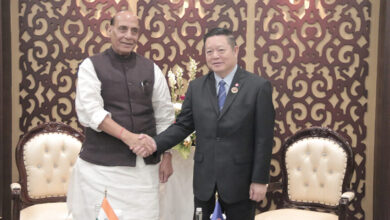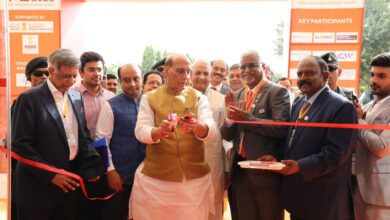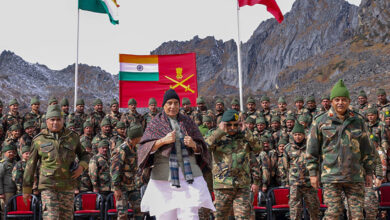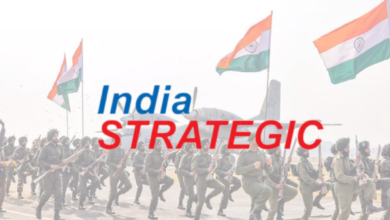HTT-40 Takes-off
The first prototype of indigenous Basic Trainer Aircraft (BTA), HTT-40 (Hindustan Turbo Trainer-40) carried out its inaugural flight June 17 at the Hindustan Aeronautics Ltd (HAL) airport in Bangalore in the presence of Defence Minister Manohar Parrikar. The aircraft was piloted by Gp Capt C Subramaniam and Gp Capt Venugopal for 10-15 minutes which consisted of take-off, some basic manoeuvring such as turns to both sides followed by a circuit and landing. The aircraft had first flown on June 1 in a proving flight.
Kudos are indeed due to HAL under its new leadership and the young team of designers and engineers which took just one year to put together the first prototype. Congratulating HAL, Mr Parrikar said, “The young team has taken a calculated risk and they have flown the aircraft within one year and kept their assurance. The indigenous content on HTT-40 is close to 80 per cent. Almost 50 per cent of the components on HTT-40 are manufactured by private players of the Indian aerospace ecosystem.
Mr Parrikar also made it a point to state that the “IAF is positive in all these developments”. This was an interesting statement as it proved wrong some quarters of the Indian press that tried to create an impression that the IAF was reluctant to acquire indigenous aircraft and equipment and fancied only imported systems.
Going back into history, it’s worth noting that post independence the IAF flew the indigenous HT-2 for three decades till mid 1970s and followed it up with HPT-32 Deepak basic trainers, both built by HAL. It is a well known fact that HPT-32 was a sub-standard aircraft (this author had flown it once in the late 90s) with a whole host of restrictions precluding its use as a full-fledged BTA. Also, it suffered from sudden engine failures, which during critical stages of flight resulted in fatal accidents. The IAF continued to put up with the aircraft even though HAL failed to find a permanent solution to the problem. The last straw however was yet another fatal accident claiming the lives of two experienced pilots in a post engine failure crash in July 2009 that led the IAF to permanently ground the entire fleet.
The IAF found itself in a Catch-22 situation as the grounding of the HPT-32 fleet, without an alternative aircraft, it was forced to use Kiran MK I IJT (Intermediary Jet Trainer) as the ab initio trainer in the basic flying role. As is well known, this led the IAF go hunting for a new BTA on a war footing and with six global manufacturers in the race; Swiss Pilatus PC-7 Mk II was chosen owing to its performance and L1 status and an order for 75 aircraft was placed in mid 2012.
During all this period, HTT-40 was nowhere on the horizon. Creditably, all 75 aircraft were delivered by November 2015, well ahead of the planned schedule, with the IAF till date having flown about 50,000 hrs with approx 100,000 landings while maintaining a superb flight line availability and flight safety record. This led to the IAF justifiably asking for its full requirement of 181 aircraft to be met through direct import/license production in India of additional PC-7 Mk II aircraft.
However, by this time HAL had chipped in with the offer of developing its own design and producing HTT-40 indigenously, instead of concentrating on its still under development HJT-36 IJT (Intermediate Jet Trainer) that the IAF was eagerly waiting for. It is a known fact that HAL is grappling with some major issues with IJT, such as, it is overweight, has yet to clear spin trials and, is powered by an engine with a TTL (Total Technical Life) of only 300 hours. Actually, there is great possibility of reversal of roles, with PC-7 Mk II taking over the Stage II training with the Kiran fleet slated for retirement in 2018 that would inevitably put more strain on the PC-7 fleet unless more such aircraft are acquired. Presently however, while an additional order for 38 more PC-7 Mk IIs is being negotiated with the Swiss company, HAL has been tasked to provide the remaining 66 with its offer of HTT-40.
The challenge for the HAL would be threefold: To develop the HTT-40 to be truly competitive to PC-7 Mk II, both in terms of performance and costs and, produce it in the scheduled time frames – of certification in 2018, in service entry in 2019 and rate of production going up to 20 per year in 2020.
It is hoped HAL’s ‘young team’ referred to above can meet the challenges and produce an aircraft that will not only complement but also take on the Stage II training along with the PC-7 Mk II, obviating the very need of a separate IJT.
The day it happens would be the day for the IAF and the nation to rejoice and, to celebrate.





